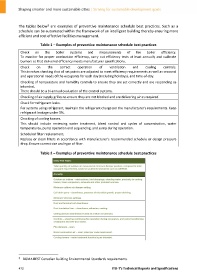Page 482 - Shaping smarter and more sustainable cities - Striving for sustainable development goals
P. 482
The tables below are examples of preventive maintenance schedule best practices. Such as a
3
schedule can be automated within the framework of an intelligent building thereby ensuring more
efficient and cost effective facilities management.
Table 1 – Examples of preventive maintenance schedule best practices
Check on the boiler systems and measurements of the boiler efficiency.
To monitor for proper combustion efficiency, carry out efficiency tests at least annually and calibrate
burners so that delivered efficiency meets manufacturer specifications.
Check on the correct operation of ventilation and cooling controls.
This involves checking that all set points are adjusted to meet efficiency requirements as well as seasonal
and operational needs of the occupants for each day (including holidays), and time‐of‐day.
Checking of temperature and humidity controls to ensure they are set correctly and are responding as
intended.
There should be a bi‐annual evaluation of the control systems.
Checking of air supply grilles to ensure they are not blocked and are delivering air as required.
Check for refrigerant leaks.
For systems using refrigerant, maintain the refrigerant charge per the manufacturer's requirements. Keep
refrigerant leakage under 5%.
Checking of cooling towers.
This should include reviewing water treatment, bleed control and cycles of concentration, water
temperatures, pump operation and sequencing, and sump during operation.
Scheduled filter replacement.
Replace or clean filters in accordance with manufacturer's recommended schedule or design pressure
drop. Ensure correct size and type of filter.
Table 2 – Examples of preventive maintenance schedule best practices
____________________
3 BOMA BEST Canadian Building Environmental Standards requirements.
472 ITU‐T's Technical Reports and Specifications

